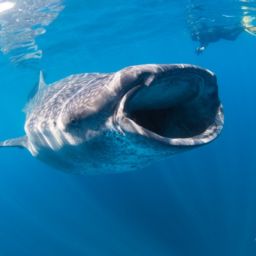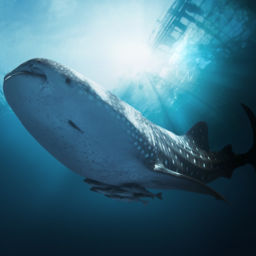By Guest Blogger Michael Maes
Ever since I started diving back in 1993, I dreamt of an encounter with a whale shark. There’s no denying it. Even if only by their sheer specs, this is an impressive animal. Adults can grow up to 65 feet long and weigh an astonishing 75,000 pounds. Whale sharks feed on the smallest animals in the aquatic food chain: plankton, krill and sprat. And add to that the fact that this animal is a shark – in other words a fish, not a mammal – and it’s all pretty amazing.
For various reasons, I’ve never encountered a whale shark until recently. And boy, this wasn’t a whale shark encounter but a whale shark congregation!
Every year between May and August, hundreds of whale sharks aggregate some 20 miles north of the Mexican island of Isla Mujeres. They feed on masses of eggs deposited by spawning Bonito tunas every night. Come morning, scores of boats head north for about an hour in search of the feeding spot of the day. Sometimes it takes a while to find the whale sharks since the spawning grounds are constantly changing.
The area where the whale sharks feed can vary a lot in size – perhaps a mile wide one day, and maybe even ten miles wide the next, as I experienced. Once I arrived on the first site, I was in for a big surprise. Scores – maybe even hundreds – of dorsal fins popped up above the water, accompanied by a slowly but steadily moving tail fin.
As far as my eyes could see, there were fins. It was very difficult for me to comprehend: such a relatively rare fish to see in the world’s oceans, yet there I was in the middle of a whole bunch of whale sharks. I wanted to gear up as quickly as possible to be with the sharks, to make eye contact with them.
So, ready to go, there I was waiting for the affirmative “Go!” from the captain. And when I got it, off I went!
Once in the water, I began looking around but didn’t see a single whale shark. “Hey, what’s going on? It was stacked with them when I was on the boat!” I thought. Then I realized my eyes were being tricked by bad visibility. Remember, you’re in the middle of a breeding ground here. So all those eggs and other biological matter does impair visibility.
I started finning toward a spot where I’d seen a shark when I was still on the boat and, bang – a huge silhouette was suddenly coming toward me. My first whale shark ever! I was so thrilled I forgot to hit the record button on my camera. I admired every square inch of the fish as it cruised by me at its famously slow pace, not minding me and staying just within touching distance (although I didn’t reach out and touch it, of course).
A couple more whale sharks cruised by me as I slowly awoke from this amazing dream. Having studied the behavioral patterns of whale sharks for a few months, I started to make test shots to determine my ideal camera settings.
When I was ready to shoot I realized I’d ran out of sharks – there were no more around me. So I started finning again to another location and bumped into a beautiful oceanic manta ray. I started filming the manta and suddenly noticed another one and then another and another…. It was too good to be true! I was completely surrounded by mantas!
“OK, lets get rolling!” I told myself. My camera was recording one barrel roll after another (a manta does this vertical rolling when it’s in a nutrient-rich spot until the food source has been devoured). Then, suddenly, the whale sharks appeared right before my lens. This is how things continued for our entire time at the site – and it was only day one of our expedition!
Boy oh boy, this was way beyond what I ever expected to witness. A youth dream became true. Not only did I encounter a whale shark, I swam among hundreds of them. These encounters are burnt into my mind for the rest of my life, I’m quite certain. And I’ll definitely go back next year for more.
Thank you Isla Mujeres. And thank you whale sharks, manta rays and mobulas….



